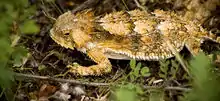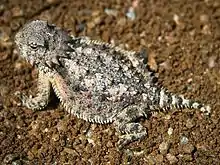Regal horned lizard
The regal horned lizard (Phrynosoma solare) is a horned lizard species native to Mexico and the Southwest United States.[3]
| Regal horned lizard | |
|---|---|
 | |
| Scientific classification | |
| Domain: | Eukaryota |
| Kingdom: | Animalia |
| Phylum: | Chordata |
| Class: | Reptilia |
| Order: | Squamata |
| Suborder: | Iguania |
| Family: | Phrynosomatidae |
| Genus: | Phrynosoma |
| Species: | P. solare |
| Binomial name | |
| Phrynosoma solare | |

Description
The regal horned lizard is a small, flat lizard about the size of the palm of a human's hand. Though it has spikes all around its body, the regal horn's main defense is the ability to squirt blood from its eyes. It is 3–4 in (117 mm) in length from nose to tail as a full adult, and pale grey to yellow-brown or reddish in color, topped with dark blotches alongside the body and back. Its four legs each have five toes with a claw on each toe. The species is a slow runner that uses camouflage to escape predators.[4]
Distribution
This lizard can be found across southeastern Arizona and along the transition of the southern zone of the central mountains region.[5]
Habitat
This horned lizard occupies primarily level or gently sloping terrain with openly spaced desert vegetation such as mesquite, creosote bush, and saguaro cactus.[3] It can be found primarily in a hot and dry climate where the ground may be covered in limestone dust.[6] It is found in the Sonoran Desert Mountains is where it prefers its climate, but can be found in Texas, southern California, Arizona, and New Mexico.[7]
Diet
They eat mostly harvester ants, and can eat 2500 ants in one meal. They are slow eaters, because they spend most of their time in the intense heat of the desert during meals. They also eat a variety of other insects, and spiders.[8]
Behavior
This is a year-round active type of lizard, but during winter, its activity is usually restricted to unseasonably warm days. It may hibernate late September through October. The lizard basks in the sun with only its head poking out of the sand. The blood is heated within a chamber inside the head. When the blood is warm enough, the reptile opens a valve in its neck and circulates the blood around the body. It looks for shelter from cold temperatures by digging holes in the ground. When it is threatened or captured, it squirts blood from its eye. This blood may have a taste used to deter predators. If the camouflage and intimidation do not work, that is when it squirts out blood, aiming for the predator's mouth and eyes. This stream can range up to 4 feet and may be repeated several times. The stream comes out through its lower eyelids' pores. Some other defensive behaviors include gulping air and poking with the horns.[8]
Reproduction
Mating for the regal horned lizard begins in late April, peaks in June, and stops abruptly in July. Egg laying starts a few weeks later, usually in late July and early August. About 10–30 eggs are laid (15 on average). The eggs are laid in the sand and are required to stay there for several weeks. The egg shells are white and flexible and average about one-half inch in diameter. The hatchlings receive no parental care upon hatching and immediately bury themselves in the sand. They are now responsible for finding and hunting for their own food. Several diverting tactics are used to attract a mate, such as head bopping, push-ups, and nodding of the head.[9]
References
- Hammerson, G.A., Frost, D.R. & Gadsden, H. (2007). Phrynosoma solare. The IUCN Red List of Threatened Species doi:10.2305/IUCN.UK.2007.RLTS.T64081A12734740.en
- "Phrynosoma solare". ZipcodeZoo.com.
- Pianka, Eric R.; Hodges, Wendy L. "Horned Lizards". Varanus: the Pianka lab page.
- Sherbrooke, Wade C. (2003). Introduction to Horned Lizards of North America. University of California Press.
- Brennan, Thomas C. (2008). "REGAL HORNED LIZARD Phrynosoma (Anota) solare".
- Suarez, Andrew; Richmond, Jon; Case, Ted (2000). "Prey selection in horned lizards following the invasion of Argentine ants in southern California". Ecological Applications. 10 (3): 711–725. doi:10.1890/1051-0761(2000)010[0711:PSIHLF]2.0.CO;2.
- Parker, William S. (1971). "Ecological observation on the regal horned lizard in Arizona". Herpetologica. 27 (3): 333–338. JSTOR 3890846.
- Mattison, Christopher (1989). Lizards of the World. New York, NY.
{{cite book}}: CS1 maint: location missing publisher (link) - "Phrynosoma solare (Regal Horned Lizard)". Animal Diversity Web.
